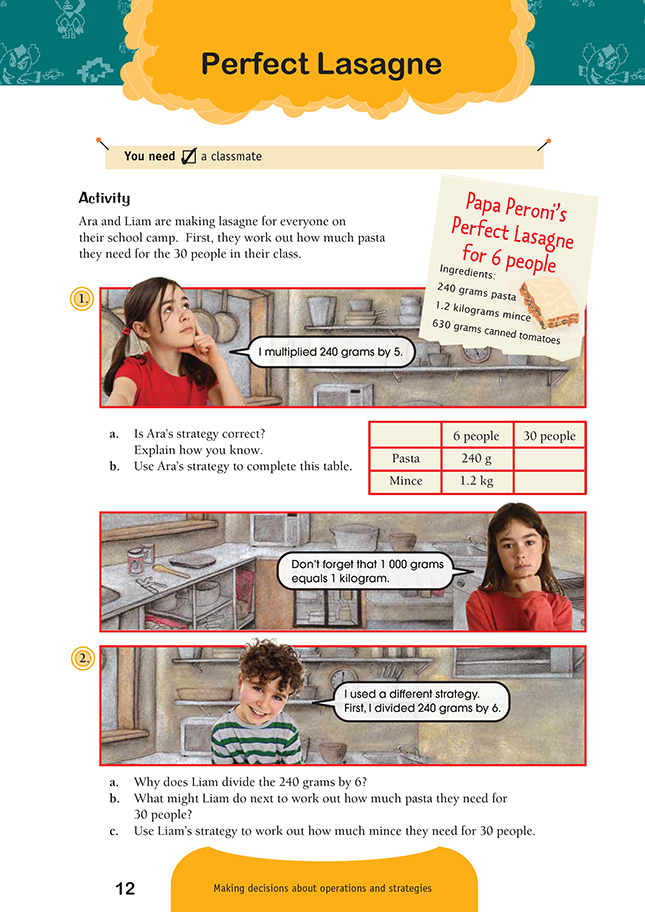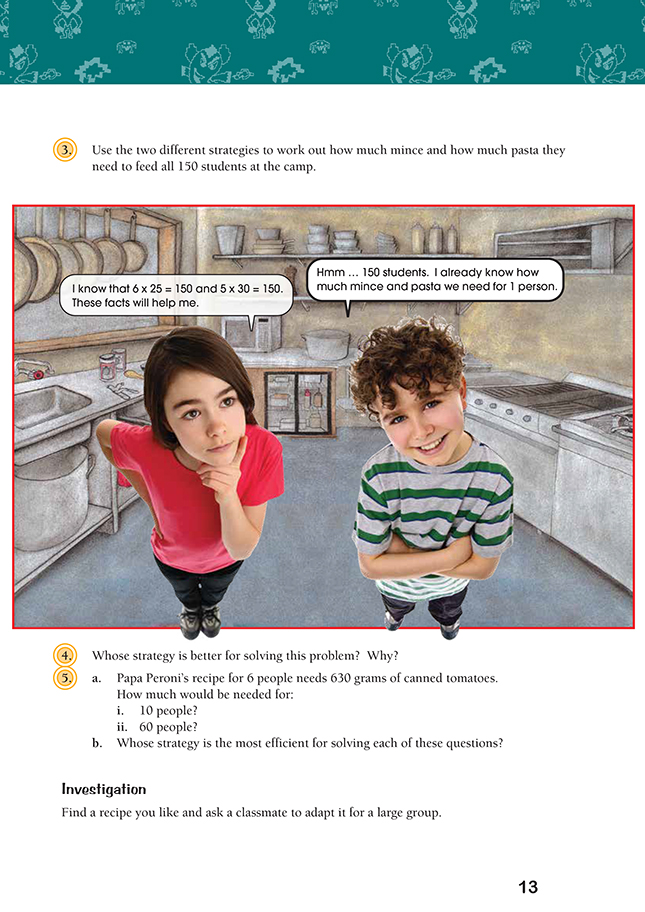This is a level 4 number activity from the Figure It Out series. It relates to Stage 7 of the Number Framework.
A PDF of the student activity is included.
Click on the image to enlarge it. Click again to close. Download PDF (533 KB)
use a proportional strategies to solve multiplication problems
Number Framework Links
Use this activity to help the students to extend their advanced multiplicative part–whole strategies (stage 7) in the domains of multiplication and division and proportions and ratios.
FIO, Level 3, Number Sense and Algebraic Thinking, Book Two, Perfect Lasanga, pages 12-13
A classmate
This activity encourages students to try two different strategies for increasing the amount of ingredients in a recipe and then to compare the efficiency of the strategies in different circumstances.
The problems involve rates where two quantities measured with different units are compared, for example, grams of pasta with number of people.
For this activity, the students will need to be able to choose flexibly from a range of multiplicative strategies. They will need to be able to multiply and divide decimal fractions by a whole number, for example, 1.2 ÷ 6, or 0.2 x 30, and to convert grams into kilograms and vice versa, for example, 1.2 kg = 1 200 g.
With a guided teaching group, discuss Ara’s proportional strategy in question 1. She works out that the recipe for 30 people would need to be 5 times bigger than the recipe for 6 people, so she multiplies each ingredient by 5. This strategy is very useful when the proportions can be easily identified and calculated. Ara’s strategy is quick and efficient in this case. It’s less straightforward if the proportion cannot be expressed as easily, such as later in the activity when she is making the recipe for 10 people and she has to multiply each ingredient by 1 2/3.
Ara could also use a proportional strategy to calculate 240 g x 5 by working out
240 x 10 = 2 400 and then halving it: 2 400 ÷ 2 = 1 200. Ara’s strategy could be shown as a double number line:
.gif)
or as a strip diagram:
.gif)
In question 2, Liam uses a different proportional strategy. He works out how much of each ingredient would be needed for just 1 person by dividing the ingredients in the recipe by 6. He then multiplies that amount by the number of people he needs to feed. This “unit rate” strategy will work in all situations, but it involves an unnecessary step when the number to be fed is a multiple of the number of people for whom the recipe was originally written.
Question 3 is useful for formative assessment. For this question, Ara could make the
original recipe 25 times bigger (6 x 25 = 150) or multiply her ingredients for 30 people by 5 (from 30 x 5 = 150). If the students have difficulty getting started, ask questions such as:
How much bigger would the recipe for 6 people have to be to feed 150 people? What about 30 people?
How might the facts in Ara’s speech bubble help?
Possible strategies for multiplying by 25 include:
• making proportional adjustments, for example:
25 x 240 = 100 x 60 (quadruple and quarter)
= 6 000
• using place value partitioning (25 x 200) + (25 x 40).
Liam will need to multiply his ingredients for 1 person by 150 people. Possible strategies formultiplying by 150 include:
• using place value partitioning, for example:
150 x 40 = (100 x 40) + (50 x 40)
= 4 000 + 2 000
= 6 000
• multiplying by 100 and then adding on half the answer, for example,
100 x 40 = 4 000. Half of 4 000 = 2 000; 4 000 + 2 000 = 6 000.
Question 5b promotes algebraic thinking because it requires the students to generalise the types of problems for which each strategy is most appropriate. Ara’s strategy works where the measurements of one object are multiples of one another, for example: 6 people 30 people.
Answers to Activities
1. a. Yes. The recipe is for 6 people. To make it a recipe for 30 people, each ingredient needs to be multiplied by 5 because 6 x 5 = 30.
b.
.gif)
2. a. To find out how much pasta would be needed or 1 person. 240 g ÷ 6 = 40 g each.
b. Liam needs to multiply the amount of pasta for 1 person by 30, that is,
40 g x 30 people = 1 200 g. If Liam finds it difficult to multiply by 30,
he could multiply by 3 and then by 10.
c. 1.2 kg ÷ 6 people = 0.2 kg each.
0.2 kg x 30 people = 6 kg.
3. Methods may vary. For example:
.gif)
4. Answers will vary. Both strategies work, but Ara’s avoids decimal fractions, so the mental maths is probably easier.
5. a. i. 1 050 g (1.05 kg) for 10 people
ii. 6 300 g (6.3 kg) for 60 people
b. Liam’s strategy would be the most straightforward for 10 people. He would
find out how much tomato 1 person would need (630 g ÷ 6 = 105 g each) and then
multiply this by 10.
Ara would need to work out that 6 x 1 2/3 = 10 people and then multiply
630 g by 1 2/3.
Ara’s strategy would be the most straightforward for 60 people: she would
multiply 630 g x 10 because 6 x 10 = 60.
If you used Liam’s strategy, it would still work, but you’d need to multiply
105 g x 60 people, which is more difficult than Ara’s calculation.
Investigation
Recipes and adaptations will vary

